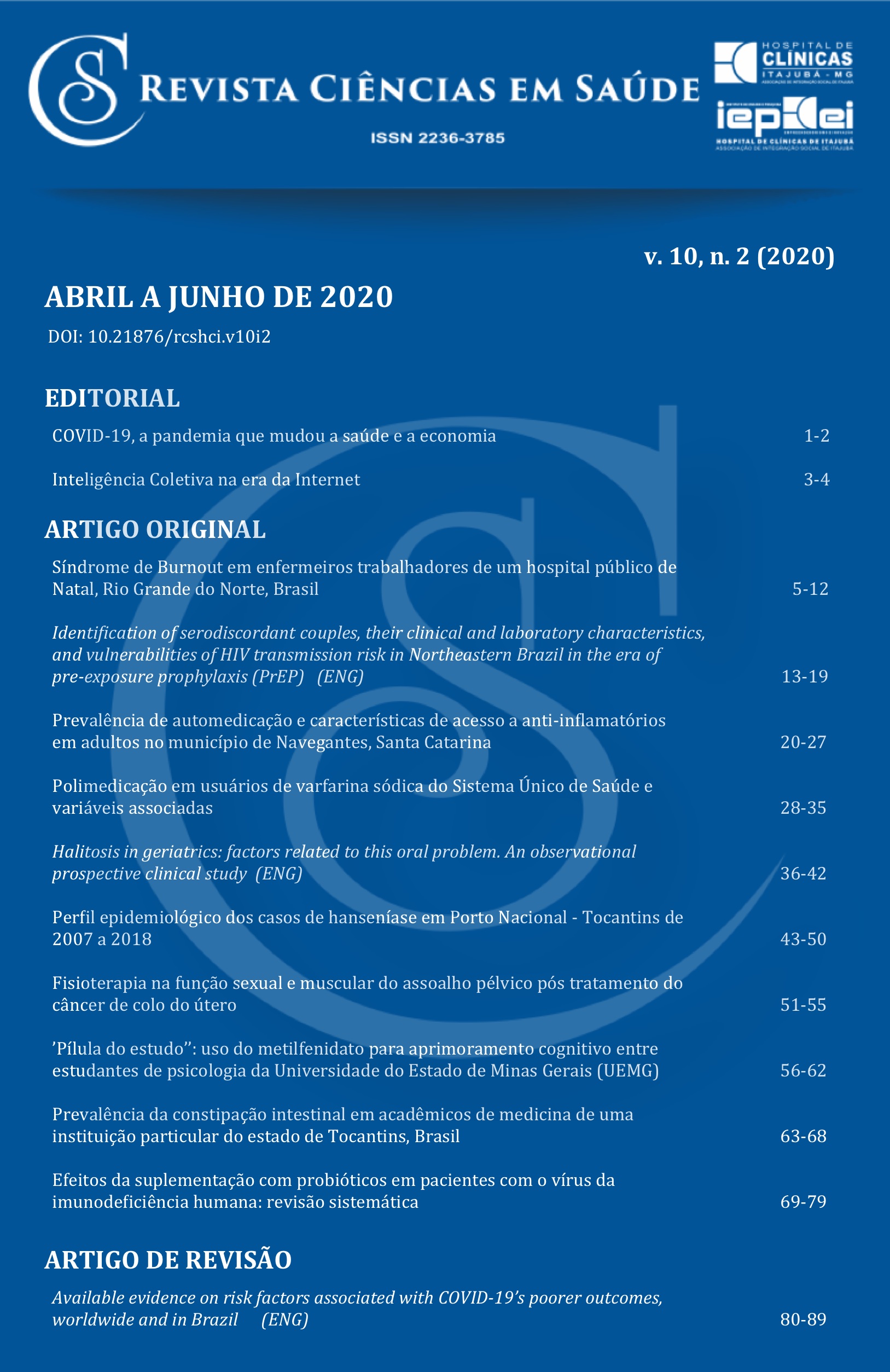Prevalence of intestinal constipation in medical students of a private institution in the state of Tocantins, Brazil
Main Article Content
Abstract
Objectives: To analyze the prevalence and characteristics of intestinal constipation (IC) in medical students from a private institution in the State of Tocantins, Brazil. Methods: Cross-sectional and quantitative study, with the application of a questionnaire to medical students from the 1st, 3rd, and sixth periods. General and specific data were collected from August to September 2018 to characterize the IC, followed by descriptive statistics. Results: Most of the 142 interviewees were from the 1st semester of the course (n = 73; 51.4%), were up to 28 years old (n = 133; 94%) and were women (n = 90; 63.4%). Most ate their meals at home (n = 106; 74.6%), and 84 (59.1%) ate four or more meals a day. The majority (n = 54, 38%) used green leaves and fruits once or twice a day. The presence of self-reported IC occurred in 22 students (15.5%), while the functional IC, characterized as an effort to evacuate or hardened stools, in 38 (26.7%). The minority (n = 27; 19%) reported an evacuation frequency up to three times a week. In addition to the effort to evacuate and hardened stools, the most prevalent symptom was the sensation of incomplete evacuation (n = 32; 22.5%). Conclusion: Intestinal constipation presents itself as an uncommon condition among students of the analyzed medical course. Evacuation efforts and hardened stools were the most common findings.
Article Details
Authors maintain copyright and grant the HSJ the right to first publication. From 2024, the publications wiil be licensed under Attribution 4.0 International 
 , allowing their sharing, recognizing the authorship and initial publication in this journal.
, allowing their sharing, recognizing the authorship and initial publication in this journal.
Authors are authorized to assume additional contracts separately for the non-exclusive distribution of the version of the work published in this journal (e.g., publishing in an institutional repository or as a book chapter), with acknowledgment of authorship and initial publication in this journal.
Authors are encouraged to publish and distribute their work online (e.g., in institutional repositories or on their personal page) at any point after the editorial process.
Also, the AUTHOR is informed and consents that the HSJ can incorporate his article into existing or future scientific databases and indexers, under the conditions defined by the latter at all times, which will involve, at least, the possibility that the holders of these databases can perform the following actions on the article.
References
Trisóglio C, Marchi CMG, Torres US, Netinho JG. Prevalência de constipação intestinal entre estudantes de medicina de uma instituição no Noroeste Paulista. Rev Bras Colo-proctol. 2010;30(2):203-9. doi: 10.1590/S0101-98802010000200012
Collete VL, Araújo C L, Madruga SW. Prevalência e fatores associados à constipação intestinal: um estudo de base populacional em Pelotas, Rio Grande do Sul, Brasil, 2010. Cad Saúde Pública. 2010; 26(30):1391-402. doi: 10.1590/S0102-311X2010000700018
Galvão-Alves J. Constipação Intestinal. J Bras Med [Internet]. 2013 [cited 2020 Apr 20];101(2): 31-37. Avaiable from: files.bvs.br/upload/S/0047-2077/2013/v101n2/a3987.pdf
Grossman SC, Porth CM. Fisiopatologia. 9. ed. Rio de Janeiro: Guanabara Koogan; 2016.
Moratoya EE, Carvalhaes GC, Wander A E, Almeida LM de MC. Mudanças no padrão de consumo alimentar no Brasil e no mundo. Rev Política Agrícola [Internet]. 2013 [cited 2020 Apr 20]; 22(1):72-84. Avaiable from: seer.sede.embrapa.br/index.php/RPA/article/view/283/242
Jaime R P, Campos RC, Santos, TST, Marques MS. Prevalência e fatores de risco da constipação intestinal em universitários de uma instituição particular de Goiânia, GO. Rev Inst Ciênc Saúde [Internet]. 2009 [cited 2020 Apr 20]; 27(4):378-83. Avaiable from: files.bvs.br/upload/S/0104-1894/2009/v27n4/a1637.pdf
Dong YY, Chen FX, Yu YB, Du C, Qi QQ, Liu, H, et al. A school-based study with Rome III criteria on the prevalence of functional gastrointestinal disorders in Chinese college and university students. PLoS One. 2013;8(1):54183. doi: 10.1371/journal.pone.0054183 .
Silva DO, Silva FI, Machado DZ, Passoni CRMS. Prevalência e correlação entre Constipação Intestinal e Ansiedade. Cad Escola Saúde [Internet]. 2012 [cited 2020 Apr 20];1(7):70-83. Avaiable from: portaldeperiodicos.unibrasil.com.br/index.php/cadernossaude/article/view/2344
Muñoz RLS, Santos LA, Martins MMC, Araújo DU, Vieira ATP, Vilar GN, et al. Constipação intestinal e fatores associados em estudantes universitários da área de saúde. Rev Salusvita [Internet]. 2016 [cited 2020 Apr 20];35(3):351-66. Avaiable from: pesquisa.bvsalud.org/portal/resource/pt/biblio-832961
Chang L, Lin Y, Lo TC, Chen M, Kuo H. Understanding the lifestyle correlates with chronic constipation and self-rated health. Food Nutr Sci. 2015;6:391-8. doi: 10.4236/fns.2015.64040
Bharucha A, Pemberton JH, Locke GR. American Gastroenterological Association technical review on constipation. Gastroenterol. 2013;144(1):218-38. doi: 10.1053/j.gastro.2012.10.028
Sanchez MIP, Bercik P. Epidemiology and burden of chronic constipation. Can J Gastroenterol. 2011;25(Suppl B): 11B-5B. PMID: 22114752
Garrigues V, Gálvez C, Ortiz V, Ponce M, Nos P. Prevalence of constipation: agreement among several criteria and evaluation of the diagnostic accuracy of qualifying symptoms and self-reported definition in a population-based survey in Spain. Am J Epidemiol. 2004; 159(5): 520-6. doi: 10.1093/aje/kwh072

